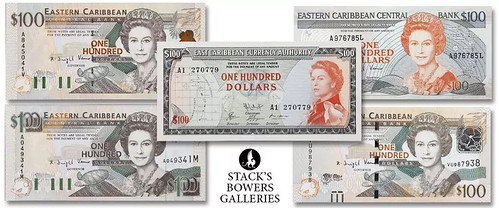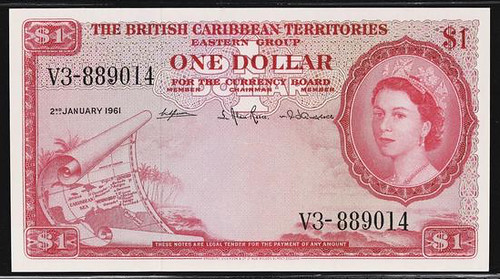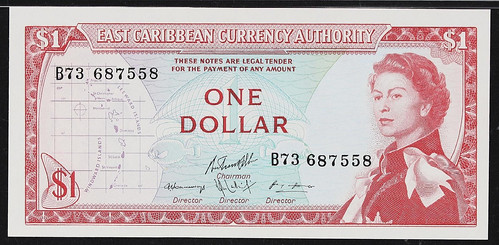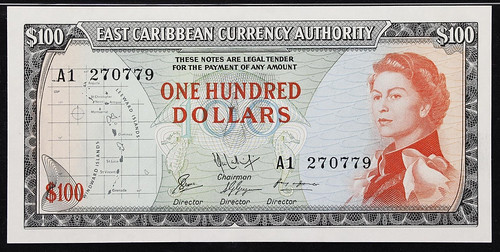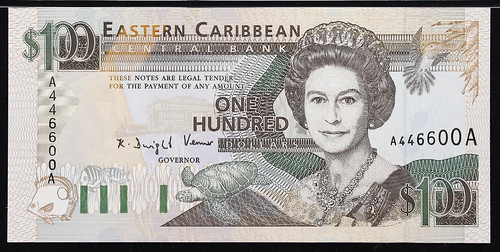
PREV ARTICLE
NEXT ARTICLE
FULL ISSUE
PREV FULL ISSUE
EAST CARIBBEAN STATES CURRENCYStack's Bowers Currency Auction Associate Joe Pyle published this article about the East Caribbean States and their currency in the firm's Paper Money of the Week column. -Garrett While working on our Summer 2025 Global Showcase Auction, a collection of East Caribbean States $100 banknotes came across my desk. Their attractive design caught my eye, so I decided to do some research and was surprised at the number of varieties available for these notes. Here I will look closely at some of these notes and their history, focusing on the $100 denomination. This blog is based on an earlier article written by my colleague Dennis Hengeveld that is no longer available online. Starting in the early 17th century, the British claimed several islands in the Caribbean, competing directly with Dutch, French, and Spanish interests in the region. Early claims included St. Kitts (the first British settlement in the region — 1624), Antigua, and Montserrat (both 1632). British control spanned a large area, with territories in both the Leeward and Windward islands of the Caribbean, collectively known as the British West Indies. Most of the islands were combined into the short-lived West Indies Federation in 1962 after initially being divided into Windward and Leeward islands. Following the dissolution, some nations gained independence while others became colonies under London authority. The British Caribbean Territories Currency Board was replaced in 1965 by the East Caribbean Currency Authority, and that same year, the East Caribbean Dollar was introduced. The islands that used the currency were Anguilla, Antigua and Barbuda, Barbados, Dominica, Montserrat, Saint Kitts and Nevis, Saint Lucia, and Saint Vincent. There were four denominations in this first series: $1, $5, $20, and $100. In comparison with the first three denominations, which are mainly red, green, and purple, the $100 is more colorful, with shades of green, blue, red, and black. A portrait of Queen Elizabeth II by Pietro Annigoni is featured on all denominations, along with the same design, and a tropical scene depicting St. George's harbor in Grenada. Regardless of where they were issued, the notes were identical during their first issuance. During this time, only the signatures on the face of the note and the list of countries on the reverse (which were countries of the Currency Union) were altered due to Grenada joining in 1968 and thw withdrawal of Barbados in 1972. Beginning in 1983, following the establishment of the East Caribbean Central Bank, a black overprint of a circled letter on the left side of the note indicated the island where the notes were first issued. The letters and corresponding countries were: A – Antigua and Barbuda D – Dominica G – Grenada K – Saint Kitts and Nevis L – Saint Lucia M – Montserrat U – Anguilla V – St. Vincent
The entire East Caribbean Series is highly collectible and has some underrated varieties that have proven to be extremely difficult to find. With some exceptions based on the series and island of issuance, the $100 denomination is generally the scarcest. It is very difficult to find some varieties in any grade, particularly in the first few series. The sale of any first issue $100 (Pick-16) is uncommon as they are very scarce to rare for all varieties, and the rarer variants only come up when specialized collections are sold. For example, while specimens exist for Pick-16m (
The East Caribbean Central Bank released a new design in December 1986. A revised portrait of Queen Elizabeth II appears at the right, along with a modified design and the same color scheme as the previous series. In this series, the island of issue is indicated by the last letter in the serial number rather than by the circled letters. Notes issued in Anguilla are an exception. The bank overprinted these notes with a circled U for St. Vincent. Oddly, Anguilla is not mentioned on the map on the right of the front of the 1986 issue. As a result, in 1988, an updated version was released. This variety has Anguilla named, and notes for that island now display the suffix The $100 notes issued in the 1980s (Pick-20 & Pick-25) have proven to be rare, especially in higher grades, even though they are relatively recent. Very few were set aside, and because of their attractive color scheme and limited availability, collectors have taken a strong interest in them. Several varieties of Pick-25 are rarely offered for sale in any grade; generally speaking, the second signature is rarer than the first. All denominations, including the $100 (Pick-30), saw significant design changes in 1993. The colors on the $100's changed to mostly brown and green on both sides, but the picture of Queen Elizabeth II stayed the same. A picture of Sir Arthur Lewis, a St. Lucian economist, is on the reverse at the left and the East Caribbean Central Bank's St. Vincent headquarters is shown on the right. The 1993 series was short-lived as there was confusion among the public due as the denominations were squeezed in the corner, making them difficult to read. A revised version, including the $100 (Pick-35), was released in 1994. This version has slightly altered colors for the letters and more spaced-out denomination digits. With just minimal changes, mostly the addition or updating of a foil security device at the upper right, this would remain the main design going forward. Among the varieties for the $100 are Gold Foil (1998, Pick-36), the engraving on the reverse slightly modified (2000, Pick-41), and Silver Foil (2003, Pick-46). In 2008, the letter indicating the place of issue was dropped (Pick-51), and marks for the blind were added in 2012 (Pick-55a). The security strip was widened in 2015 (P-55b), and this was the final paper $100 for the East Caribbean States. The Eastern Caribbean Central Bank announced on September 5, 2018, that it would introduce a new series of polymer notes starting in the middle of 2019. This issue would keep the same color schemes and denominations as previous issues but would feature new designs and a vertical orientation. We currently have a number of scarce $100 varieties offered in the Mid-Year 2025 World Paper Money Auction. Additional notes will be featured in the Summer 2025 Global Showcase Auction, scheduled for August. To take advantage of the strong market and to consign to one of our upcoming sales, please contact Dennis Hengeveld at Dennis@stacksbowers.com or Aris Maragoudakis at Aris@Stacksbowers.com.
To read the complete article, see:
Wayne Homren, Editor The Numismatic Bibliomania Society is a non-profit organization promoting numismatic literature. See our web site at coinbooks.org. To submit items for publication in The E-Sylum, write to the Editor at this address: whomren@gmail.com To subscribe go to: Subscribe All Rights Reserved. NBS Home Page Contact the NBS webmaster 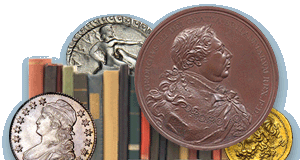
|
